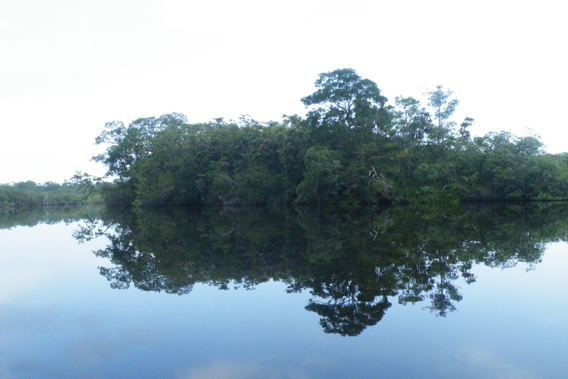
Dawn breaking over Black Creek, Sarstoon Temash National Park. Photo by: Robin Oisín Llewellyn.
The Belizean government has approved an application by US Capital Energy to drill exploratory wells for oil in the Sarstoon Temash National Park in southern Belize.
The decision is believed to have been taken on November 1st by the National Environmental Assessment Committee (NEAC) of the Department of Environment, but the exact terms of the settlement have not yet been made public. The oil company,
backed by US energy investment group Aspect Holdings, has applied to drill at five points in the
Sarstoon Temash National Park and adjacent areas.
While oil extraction in national parks is banned under the Belizean National Parks Act, the government is largely satisfied with the company’s environmental statement
(ES) for exploratory drilling in the “Block 19” concession covering the park and neighbouring indigenous areas. NEAC has reportedly made its approval
conditional on the provision of further information relating to the proposed treatment of drilling mud, and relating to the company’s oil spill response
plan. It has also requested clarification on whether the company will dredge waterways, and has demanded the survey questionnaires that US Capital Energy
was to have circulated as part of its social assessment.
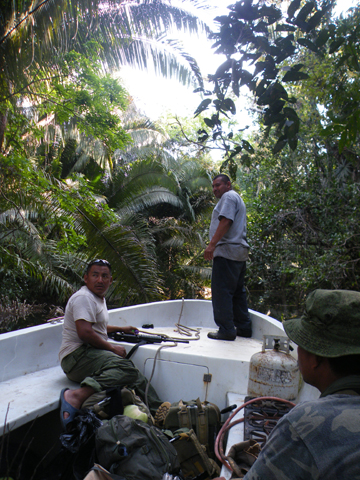 A SATIIM patrol in the national park, escorted by the Belize Defense Force. Photo by: Robin Oisín Llewellyn. |
Sarstoon Temash National Park (STNP) is the second largest national park in Belize, and is listed under the Ramsar Convention as a wetland of international importance. It comprises
16,590 hectares of permanently and seasonally inundated tropical evergreen lowland forest, Manicaria swamp forest, and lowland peat shrubland. The only
known comfra palm forest in Belize grows within the park boundaries, as do the region’s best stretches of undisturbed red mangrove
forest. STNP is also home to the only known low-lying sphagnum moss bog in Central America, which fosters flower species believed to be unique.
Three assessments of US Capital Energy’s environmental statement were carried out by analysts from or on behalf of Belizean environmental NGOs, and all
found the company’s proposal to be “fatally flawed.” The scientific team of the Toledo Institute for Development and Environment (TIDE) highlighted the potential for toxic drilling materials and
benzene escaping from the well shafts, and in their evaluation
noted that the largest fault line in Central America runs through the park which could fracture the bore holes leading to groundwater contamination.
TIDE also drew attention to a fatal flaw in the company’s failure to detail the chemicals that will be added to the drilling fluid, and its provision of
contradictory information on whether drilling fluid would be water based or pseudo water based.
The government’s decision is the latest act in a long running drama that has pitted US Capital Energy and the government against the indigenous community
organization which co-manages the park, the Sarstoon Temash Institute of Indigenous Management (SATIIM).
The rangers of SATIIM are drawn from the indigenous Mayan and Garifuna communities that border the National Park, and they have been patrolling the area
throughout the company’s exploration phase which saw increased illegal logging along seismic lines, disruption to the park’s fauna, and the burning down of
over 250 acres of the unique sphagnum moss bog.
An evaluation on behalf of SATIIM by environmental
consultant Richard Steiner also found US Capital Energy’s drilling project to be flawed on the following grounds:
- That the project violates the purposes and regulations of the protective designations of the STNP, which falls within IUCN category I and II protective
status, as well as being recognized under the RAMSAR Convention.
- Contradictions exist in the ES’s claim that “There will not be any adverse impact on the terrestrial flora and fauna of the area,” with its admission in
section 16.3.5 that a spill would “create serious impacts to wildlife and the local economy”. The environmental statement does not further discuss this
potential for the serious social as well as environmental impact from a major spill.
- Section 15.4 discusses Response Measures in the Event of a Major Oil Spill, but in a vague and general way: At the time of a spill, “a program of
management and control options will be put together.” Thus, there is no pre-established Oil Spill Contingency Plan discussed, detailing equipment
available, response approaches, etc. As well, there is no development of a worst-case oil spill scenario.
- The ES does not consider or discuss any potential impacts to the offshore marine ecosystem, which could be impacted by an oil spill flowing down the
Temash River and then offshore towards Honduras and Guatemala, or from a vessel transporting diesel fuel for generators at the drill sites.
-
The ES and its
appendices
do not specify how blowouts, such as that which caused the Deepwater disaster, will be prevented. Steiner writes: “The broader and more important issue
of blow out prevention includes well design and well integrity management, yet Appendix B does not discuss this at all. Section 15.2 discusses these
issues in only very general terms (e.g., that certain valves and devices will be installed, etc.) without any further detail. The ES does not detail
well design and well integrity management in necessary detail, and it does not discuss anticipated reservoir pressures, BOP pressure ratings, casing
design, cement slurry formulation, pressure testing during drilling, and plans to manage pressure anomalies (e.g. “kicks”) during drilling. The ES
fails to acknowledge any commitment by the operator to comply with American Petroleum Institute (API) and American Society of Mechanical Engineers
(ASME) standards, which are the global industry standards. The API standards also incorporate the U.S. Integrity Management (IM) protocols, and
designate High Consequence Areas (HCAs) where consequences of an oil spill are greater, thus requiring enhanced design standards. Yet the ES does not
discuss this.”
- Two drilling sites, A and E, are located within the park. A is located 200m from the Temash River, while E is in the heart of the sphagnum moss bog. The
ES downplays the company’s interest in drill site E, and does not state how transportation will arranged to reach it, merely saying that “further studies
will be carried out”. Yet the statement is a request of approval by the operator to drill at the site.
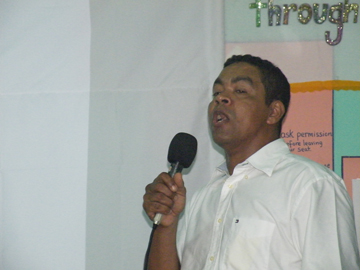 Allan Herrera of US Capital Energy presenting the environmental statement, Sunday Wood, Belize, 25 October. Photo by: Robin Oisín Llewellyn. |
Scientists from the Environmental Law Alliance Worldwide (ELAW) highlighted the dangers to biodiversity of the access
roads, which destroy selected areas of vegetation to fragment and ultimately degrade rainforest ecosystems. In their evaluation they wrote: “Such fragmentation is the principal cause of the loss of ‘area-sensitive’ species
…and is considered the most serious threat to biological diversity.”
The evaluations of the ES also highlighted the hitherto unresolved legal injunctions against oil exploration stemming from the Supreme Court’s rulings of
Maya land claims in the area. The Q’eqchi’ Maya rainforest communities on whose lands US Capital Energy hopes to drill had long campaigned for full legal
title over the territories on which they relied for their livelihoods, and their claims were settled by the Supreme Court in 2007 (for two Maya villages) and 2010 (for
22 further Maya villages).
The government has so far refused to comply with the rulings’ instruction to issue written collective land titles to the communities, and currently is
appealing the 2010 decision. No oil exploration or extraction can occur on these contested lands with or without the consent of the inhabitants until the
government issues written title to the indigenous villages.
While Prime Minister Dean Barrow argues that the Supreme Court rulings don’t influence the prior agreements made with US Capital Energy, the eight year production sharing agreement made between the Belizean
Government and US Capital Energy in January 22, 2001 (revised on January 2, 2004) has expired, leaving the project currently progressing without a legal
basis.
The prominence of the 2007 and 2010 rulings has been heightened by the decision of four of the indigenous communities bordering the park to explicitly
withhold their consent from US Capital Energy’s project, and to nominate SATIIM as their representative in negotiations with both the company and the
government.
US Capital Energy presented its ES to a crowd it had bussed into the Maya village of Sunday Wood, a community it has heavily invested in and whose Alcalde
(mayor) Mateo Tush supports drilling. A collective letter from the leaders of five Maya and Garifuna
indigenous communities to the Chief Environment Officer and NEAC chairperson Martin Alegria requesting a delay to NEAC’s decision until they could review
all relevant information in the ES went unanswered.
The meeting on October 25th saw SATIIM director Gregory Ch’oc being silenced, his microphone grabbed
by Martin Alegria. All members of the public had their participation limited to one minute of speaking time. US Capital subsequently announced its
satisfaction with the success of the meeting, but its optimism may prove short-lived.
Statements from the rainforest communities of Conejo,Crique Sarco, Graham Creek, and Midway have asserted that they withhold their free, prior and informed consent to the drilling project,
and at their request SATIIM has contracted leading American law firm Sheppard, Mullin, Richter and Hampton LLP
to uphold their rights under the Supreme Court rulings.
Bulldozers are now entering the communities to create access for drilling, with a 13-meter wide road to Drilling Site A being measured by US Capital Energy
engineers.
Related articles
Deforestation accelerates in Belize
(08/09/2012) Deforestation in Belize has accelerated since late 2010, reports a new satellite-based assessment of the tiny Central American country’s forest cover by CATHALAC (the Water Center for the Humid Tropics of Latin America and the Caribbean).
Oil company blamed for fire in Belize national park
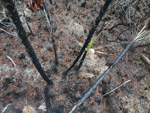
(05/01/2012) At the end of March in southern Belize the sun beats down through blackened trees onto what was the only known low-lying sphagnum moss bog in Central America. Now it is an expanse of ash and pale crusts of burned moss onto which dragonflies settle briefly before passing on. Fire spread through the area at the end of February 2012, and since then reeds have begun to sprout, but otherwise it remains a scene of devastation with no sign that the moss is regenerating.
Belize enacts moratorium on rosewood
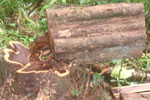
(03/20/2012) The Belizean Government has banned the harvesting and export of rosewood with immediate effect, in response to the widespread clearing of the hardwood species for the Asian market. A government statement released on Friday, March 16th claimed the moratorium was necessary “to carry out an orderly assessment of the situation on the ground and as a first response to regulate the timber trade occurring in southern Belize.” The government would subsequently institute “a rigorous regulatory framework throughout the country.”
Airborne lasers discover undocumented deforestation in Belize park
(03/19/2012) A NASA funded expedition using airborne lasers to study ancient Mayan ruins has also documented widespread illegal deforestation in the Caracol Archaeological Reserve. The lasers found that forest disturbance was actually 58 percent greater than recent satellite surveys showed, according new study in mongabay.com’s open access journal Tropical Conservation Society (TCS). Such deforestation not only imperils biodiversity, carbon storage, and migration routes for Central American species, but could also lead to plundering of the Maya site of Caracol.